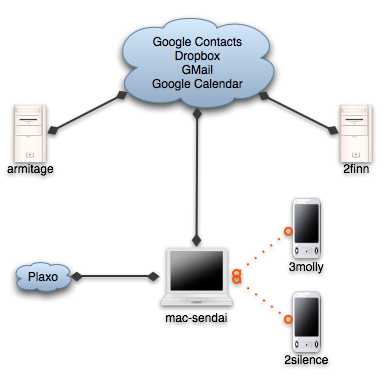A couple of weeks ago I did a presentation for a .net user group (netponto) here in Portugal about Lucene.net, an open source textual search engine. You can see the slide deck here, and I've uploaded the source code used in the demo to my github page.
What went well
Using git (with the git-extensions gui) to bookmark the various steps I wanted for the code demo. This is something that surprised me on how well it worked and actually ended up being remarked upon. It also generated a few questions about git that were answered mid-demo in a bit of a detour.
The pattern here is to build the demo as a series of linear git branches, each a small step in the demo, and instead of writing the code in-loco at the demo or storing snippets to be used, I just move up along the branches. Each step is small and self contained, and I spend more time just highlighting the important parts and the decisions I made and less time typing.
Also, using git gives me the advantage to rewrite history, so that if I figure out that the demo app needs to have a foo somewhere from the start, I can switch to the root branch, make the edit, and rebase the branches to update them with the change. With some care, this propagates the change upwards with little to no conflicts.
Short deck of slides, demo with ongoing q&a. While the initial presentation didn't take long, the demo ended up going into overtime. If there's no hard and fast timebox, this is good, otherwise answering questions in the middle of the demo can push a well timed demo out of its allotted time. But the audience seemed to be enjoying it, and I think this helps spread knowledge a bit better than just giving a presentation and showing code.
What could have been better
The "oh dear, a crash" gimmick had an interesting effect, but I think it was wasted on a slightly minor point. A better and more important part to emphasize would have been the impact of the analyzer on both indexed fields and search query. I should have had an unexpected result for a search be the "crash" and not the lack of values for fields.
I used a transition I saw on slide:ology in 3 slides, which while cool, might have been more distracting than useful. On the other hand, I think it emphasized the fact that the index was shared between the indexer and the searcher, which part of the point I was trying to make.
What I'll improve
Relax. Although the feedback I gathered from some of the audience was that it didn't show, I felt like I had zipped through the initial presentation. Ended up taking a bit of a breather while answering questions.
Might be interesting to consider dropping even more slides in detriment of more code. Although I think there's a minimum needed to intro the subject matter. Otherwise people will look at the code but the concepts will not gel.
Feedback
If you were there, I'd love to hear from you. I've received the report from Caio with the flattering comments, but I'd also love to hear your opinion on what could have been improved.

